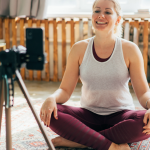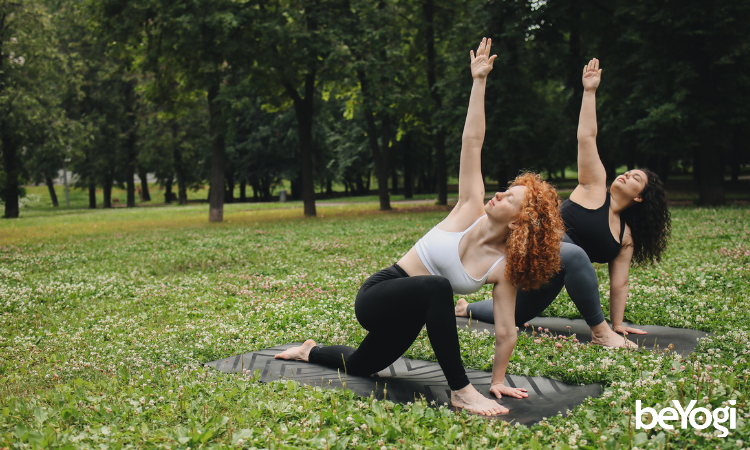
Online Yoga Teacher Training or In-Person? Pros, Cons, & Which is Right For You
September 3, 2025
How To Build Confidence In Front of the Camera
September 9, 2025Your Ultimate Guide To Chair Yoga

The yoga world is leaning more and more into accessibility. For this reason, you may be seeing or hearing about chair yoga more now than in years before. In fact, the search term “chair yoga” was at its highest search interest ever in January 2024 (according to Google Trends).
There are a lot of benefits to chair yoga. Chair yoga may be the only attainable intro point to yoga for many populations but even those who can take more traditional yoga classes can enjoy chair yoga. There is a lot to learn about this yoga practice that is growing in popularity and availability. Let’s take a look.
Key Takeaways:
- What is chair yoga? Chair yoga is a gentle, adaptable form of yoga that can be done while seated or using a chair for support.
- Chair yoga benefits: It offers physical and mental health benefits, including improved flexibility, strength, and relaxation.
- Chair yoga is great for accessibility: Seniors, beginners, people with injuries, and those with limited mobility can all benefit from chair yoga.
- Expand your career: Teaching chair yoga can expand a yoga instructor’s audience and increase income opportunities.
- Get certified: Specialized training and resources are available to help yoga teachers confidently lead chair yoga classes.
- Make sure you’re covered: Professional yoga insurance is important for instructors, including those who teach chair yoga.
Understanding Chair Yoga: What Instructors Should Know
What Is Chair Yoga?
As the name suggests, chair yoga is done in a seated position in a chair, typically one without arms, like a folding chair or a kitchen chair. A chair yoga practice can include breathwork, meditation, and yoga postures. Sometimes, the postures are done standing and using the support of the chair.
Chair yoga is proof that yoga is truly for everyone. It removes some of the most obvious barriers to entry, like mobility, health, age, and physical ability.
But it isn’t only for populations dealing with these limitations. Chair yoga is a great option if you’re sitting at a desk all day, recovering from an injury, or if you are traveling in a car or plane for long periods of time.
Does Chair Yoga Really Work?
Yes, it really works. It’s important to remember that yoga is more than handstands and chaturangas. All eight limbs of yoga encompass the practice and only one is yoga asana (the yoga postures).
Additionally, yoga asanas that are done in a chair can have similar, if not the same, benefits when it comes to stress relief, flexibility, and mobility.
Who Can Benefit From Chair Yoga?
All populations can experience chair yoga benefits, but chair yoga is especially helpful for older adults. Yoga is traditionally done on the floor, but older adults and other people with limited mobility may find getting up and down from the floor challenging or uncomfortable.
When practicing balancing postures, chair yoga helps the practitioner be safe. It’s also helpful for people who can’t or don’t regularly spend time standing. They can feel supported and experience chair yoga benefits.
Some Must-Know Benefits Of Chair Yoga
Accessibility
Chair yoga is accessible to folks of all ages and physical abilities, as mentioned above. But it also doesn’t require expensive yoga mats, clothes, or props. It may be helpful to have blankets, blocks, or straps, but even those can be substituted with objects already in someone’s home (blankets, towels, belts, etc).
Health
Yoga has many health benefits. Less stress, less back pain, lower risk for heart disease, etc. Though the studies on chair yoga are still growing, it has the same benefits as yoga but with the additional support and safety of the chair. So, in a way, an added benefit is that it reduces the risk of yoga-related injuries.
Improved Balance
You can guess (correctly) that muscle activation is higher in standard standing yoga postures. However, this study shows that core activation is higher during seated postures. Core strength is important for improving balance, among other important things that bring people to yoga in the first place.
Self Awareness
Chair yoga, like traditional yoga, emphasises mindfulness and proprioception - where your body is in space. These practices can help us learn more about our minds, thoughts, feelings, and body.
Stress Relief
According to a study published in January 2012 in the journal Evidence-Based Complementary and Alternative Medicine, fifteen minutes of chair yoga or guided meditation greatly improved several physiological and psychological stress markers.
Pain Management
Chair yoga has been found to reduce pain. Additionally, chair yoga teaches various breathing and visualization techniques that can be used to focus and reduce pain throughout the body.
Why Teach Chair Yoga?
As a yoga teacher, you want to do your best to improve the lives of your students. One way to do that is to become a chair yoga teacher. Getting specialty certifications are not only helpful for fulfilling your continuing education credits, it’s a great way to make sure that you’re up to date on teaching techniques and a useful tool when creating your own fulfilling career in the yoga world. Here are some other ways becoming certified in chair yoga might be a great choice for you:
Popularity and Demand
Chair yoga is becoming increasingly popular and available in studios, not just on YouTube. You may be able to tap into a much-needed and understaffed space in your yoga community.
Increase Income
Helping more people means getting more work! Yoga teachers aren’t always in the career for the money but keeping the lights on is important when those lights are how you get to keep getting to do what you do! Becoming a chair yoga teacher can be a great way to diversify your income and reach new audiences.
Teaching Yoga to Older Adults and Special Populations
Teaching to seniors and other populations is not only extremely valuable and needed, it is also one way to tap into new communities, facilities, and brands. If you’re interested in developing relationships with assisted living homes, physical therapists, holistic doctors, or other brands and services that work with these groups, becoming a chair yoga teacher is a great way to do that.
Alternatives for teaching people with injuries
Even if you don’t want to work specifically with communities that need chair yoga, it is always good to have more alternatives in your pocket for when someone comes into the studio or comes to you for private yoga who has a specific injury. This way, you have something safe and gentle for them no matter what they’re working with that day.
How To Get Started Teaching Chair Yoga
Training
Many chair yoga training programs are 40 or 60 hours. These all count towards CEUs, so one training would cover your three-year requirement through Yoga Alliance. Just like when you got your 200-hour certification, it’s important to find a reputable training. Use a directory like Yoga Alliance or check out beYogi’s member benefits to see if one of the affiliate training is right for you.
Resources
Once you get your certification, you may want to continue to learn and deepen your knowledge of chair yoga. beYogi offers resources on our website, including:
- Webinars like Skills for Adapting Popular Yoga Poses with Jivana Heyman
- Chair Yoga 101
- beYogi partners and member benefits for yoga props, yoga schools, and more
Requirements
To become a certified chair yoga teacher, you need to meet the following requirements:
- Complete a 200hr yoga teacher training
- Take a specialized chair yoga certification
- Optional: register as a yoga teacher on Yoga Alliance and keep up with the continuing education and standards
Free Download
Chair Yoga 101: 3 Tips To Share Safe, Effective Practices
Chair Yoga Exercises
Here are a few examples of chair yoga postures that you might expect to teach and learn more about in a chair yoga teacher training.
Cobra
With feet flat on the floor, press down into your seat and lengthen your spine, sitting tall. Reach your hands back to the seat of the chair (or by the legs) and lightly press your grip into the chair. Roll your shoulder blades together and down your back, widening your collarbone, as you inhale. Stay for 3-5 breaths.
Twists
Scoot forward a little in the chair. Extend arms overhead as you inhale and lengthen your spine. On your exhale, turn to your right, with the right arm resting on the back of the chair and the left hand finding your right knee. Inhale to lengthen and exhale to twist, keeping your shoulders away from your ears. Stay for 3-5 breaths. Switch Sides.
Forward Fold
Seated: Scoot forward a little in the chair. Extend your legs out in front of you (legs never have to be straight). Inhale and extend your arms overhead, exhale and fold, walking your hands down your legs as far as you feel comfortable while keeping your spine long.
Standing: Standing behind the chair, take one step back from the top of the seat’s back. Extend arms overhead with an inhale. As you exhale, allow your hands to find the chair’s back and fold as much as you are comfortable - simply looking down or coming all the way down to rest your head on your hands on the chair.
Warrior 2
Seated: Scoot forward in the chair slightly and walk your right leg to the right side of the chair so your right toes are pointing to the right and your upper leg is supported by the chair. You may like to adjust your seat so your upper leg feels the support more fully. Then extend your left leg back, straightening as much as possible comfortably (it never needs to get straight). Keep your back foot flat on the floor, with the left toes facing out, and press into the outside edge of your foot. Stay for 5 breaths. Switch sides.
Standing: Standing behind the chair, hold on to the chair back and heel-toe your feet wide. Extend your right arm to the right, at shoulder height, with your palm face down. Point your right toes out to the right and bend deeply into the right knee (as much as safely possible) while keeping the left leg straight. Press into the outside edge of the left foot. Stay with your left hand or fingertips on the chair back, or experiment with lifting the hand off the chair to reach your left arm in the opposite direction. Stay for 3-5 breaths. Switch sides.
Seated Pigeon
With feet flat on the floor, cross right ankle over left knee. Press down into your seat to extend through the top of your head. You can stay here or you can use your right hand to gently encourage your right knee away from your chest. Breathe and stay for 3-5 minutes. Switch sides.
Need Chair Yoga Insurance? beYogi Covers You
beYogi has a specialized form of liability insurance designed to protect yoga teachers who lead chair-based yoga classes.
No matter how gentle the modality, it’s important that you have good insurance to keep you covered and safe while you’re out there helping others.
Get Yoga Insurance & Protect Your Yoga Teaching Career Instantly
Save $24



